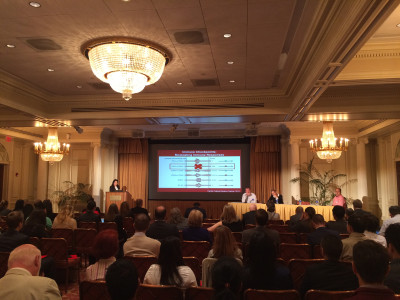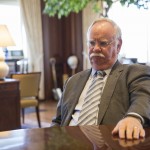
The Boston University Henry M. Goldman School of Dental Medicine hosted its second Head and Neck Cancer Symposium together with the Dana-Farber Cancer Institute Monday. The symposium, titled “From Pathways to Therapies,” aimed to bridge the gap between advanced research and clinical application through conversations and poster sessions.
Held partly in the Metcalf Trustee Center, the panel and presentation brought together scientists and clinicians from different regions of the country and varied disciplines. Guests were also able to view a poster exhibition from a range of universities, institutions and vendors that elaborated on matters regarding head and neck cancer.
Approximately 70 attendees came to the four-session symposium, hoping to explore matters of current research and therapy on the “etiology, pathogenesis, metastasis and treatment of head and neck cancer,” the event’s website stated. The symposium also included a keynote address from cancer researcher and professor Lewis Cantley of the Weill Cornell Medical College.
BU School of Dental Medicine Associate Dean for Research and symposium co-chair Maria Kukuruzinska began the symposium by emphasizing the importance of having dialogues like these to accompany scientific development.
“It is our job and our intent to be able to have conversations and bring together the most recent findings and research and merge them together with what’s happening in new technology and treatment,” she said in her opening statement.
Addressing the high importance of this meeting, Kukuruzinska presented statistics from the American Cancer Society, showing that an estimate of almost 60,000 new cases in head and neck cancer will be diagnosed in 2015 in the United States alone, causing 12,000 deaths and costing $3.6 billion.
“Worldwide, there will be 500,000 cases diagnosed [in 2015] and 300,000 deaths,” she said in her opening remarks. “Despite great progress in molecular genomics and understanding medicinal landscape, the results in terms of treatment and survival are still relatively depressing.”
The symposium explored topics such as targeting pathways and epidemiology, new technologies and patient care delivery, current and future therapies as well as clinical problems and challenges. Attendees were allowed to ask questions after each session for further conversations on the topic.
Jeffrey Hutter, dean of the School of Dental Medicine, said that the symposium “builds on the great success of the inaugural head and neck cancer symposium.” In his opening statement, he encouraged guests to “participate fully and contribute towards making this symposium even more of a success.”
After the event, Hutter said that although the majority of attendees were clinicians and professional researchers, students can indirectly benefit from these talks.
“We have a very robust pre-doctoral research program, so certainly the students right from that aspect are now fully aware of head and neck cancer, oral cancer and the symposium itself,” he said. “They get right into the conversations.”
Hutter added that the BU community should be aware of this topic and understand that the causes of these diseases are a part of a student’s daily life.
“There was information on sexually-transmitted diseases, the role that they play in oral cancer,” he said. “Head and neck cancer … smoking and alcohol … these things matter and they affect everyone.”
Several attendees said they looked forward to getting the latest information on head and neck cancer and aimed to participate in all of the four sessions.
Weihao Wang, a recent biology graduate from University at Albany, said he came to Boston to work with Kukuruzinska and plans to apply to the School of Dental Medicine for graduate studies.
“I’d like to have more information about cell-signaling in the pathway,” he said. “Head and neck cancer is definitely one of my interests.”
Shahram Navid, currently a dentist in Boston and a former dental graduate student at BU, said he expected a more detailed presentation on research development as sessions move forward, and suggested that students take part in research opportunities.
“I’d like to hear more about the new research. How we can diagnose [illness] before seeing all these things happen to the patient?” the 2013 graduate said. “It’s good for the school and for the students because the faculty is going to transfer everything they know to the students.”














